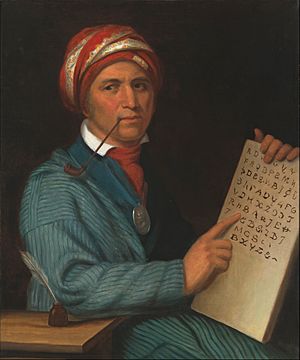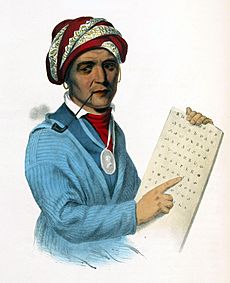Cherokee facts for kids

Sequoyah, who created the Cherokee syllabary, painted around 1830
|
|
| Total population | |
|---|---|
| 316,049 enrolled tribal members (Eastern Band: >13,000, Cherokee Nation: 288,749, United Keetoowah Band: 14,300) 819,105 claimed Cherokee ancestry in the 2010 Census |
|
| Regions with significant populations | |
| United States California: large ethnic diaspora community, 22,124 registered tribal members |
|
| Languages | |
| English, Cherokee | |
| Religion | |
| Christianity, Kituhwa, Four Mothers Society, Native American Church |
The Cherokee (Cherokee: ᎠᏂᏴᏫᏯᎢ, romanized: Aniyvwiyaʔi or Cherokee: ᏣᎳᎩ, romanized: Tsalagi) are one of the indigenous peoples of the Southeastern Woodlands of the United States. For a long time, they lived in what is now parts of North Carolina, Tennessee, South Carolina, Georgia, and Alabama.
By the 1800s, American settlers called the Cherokee one of the "Five Civilized Tribes" because they lived in wooden houses, farmed, and even created their own writing system. However, the U.S. government later forced many Cherokee to move west. This sad journey, starting in 1836, is known as the Trail of Tears.
Today, there are three main Cherokee tribes that the U.S. government officially recognizes. These are the United Keetoowah Band of Cherokee Indians (UKB) in Oklahoma, the Cherokee Nation (CN) in Oklahoma, and the Eastern Band of Cherokee Indians (EBCI) in North Carolina. The Cherokee Nation is the largest tribe in the United States, with over 300,000 members.
Contents
What does "Cherokee" mean?
The Cherokee people call themselves Aniyvwiyaʔi (ᎠᏂᏴᏫᏯ). This name means "Principal People."
How do the Cherokee speak and write?

The Cherokee word for their language is Tsalagi (ᏣᎳᎩ). The Cherokee language is part of the Iroquoian language family.
It is written using a special system called a syllabary. This syllabary has 85 letters and was invented by a man named Sequoyah. He is one of the few people in history to create a widely used writing system all by himself. His 6-year-old daughter, Ayokeh, was the first to learn it. In just a few years, most of the Cherokee people learned to read and write using this new system.
Cherokee History
How did Cherokee villages look?
The Cherokee lived in villages across the southeastern United States. These villages were usually built near rivers and had about 50 homes. Their homes were made from wooden logs and covered with grass and mud. This helped protect them from the weather.
What did the Cherokee eat?
The Cherokee did not follow animal herds like some other Native American tribes. Instead, they became skilled hunters, gatherers, and farmers. Their diet included rabbit, deer, turkey, bear, and wild plants. They also grew corn, squash, and beans.
After Europeans arrived, the Cherokee started growing new foods. These included watermelon, peaches, apples, sweet potatoes, and black-eyed peas.
How did the Cherokee travel?
To travel short distances, the Cherokee walked on trails. They also used canoes on rivers. They made these canoes by hollowing out large tree logs. After Europeans brought horses to America, some Cherokee also began to use horses for travel.
Cherokee and European settlers

John Ross was a very important leader for the Cherokee people. His father came from Scotland before the American Revolutionary War. His mother was part Cherokee and part Scottish. John Ross started his public work in 1809.
The Cherokee Nation was officially formed in 1820, with elected leaders. John Ross became the chief of the tribe in 1828 and remained chief until he passed away.
When white settlers came to America, some Cherokee began to move. They crossed the Mississippi River and settled in what would later become Arkansas and Missouri. However, the U.S. government wanted more land.
In 1832, Congress passed the Indian Removal Act. Then, in 1836, the Treaty of New Echota was signed. These laws meant the U.S. government could force the Cherokee to move west to Oklahoma. Some Cherokee leaders signed the treaty, hoping they would at least get paid for their land. But other leaders were very upset and did not want to move at all.
The Trail of Tears began in 1836. This was a forced journey where many Cherokee people suffered and died. Some Cherokee managed to stay on their old lands in Arkansas. Others worked with the United States to try and keep their independence as a state with its own government.
In 1848, a group of Cherokee went on a trip to California to find new places to live. They followed the Arkansas River to the Rocky Mountains and then went north into Wyoming before turning west. This path became known as the Cherokee Trail.
Later, laws like the Dawes Act of 1887 and the Curtis Act of 1898 started to take away Cherokee rights. After Oklahoma became a state in 1907, the U.S. government chose chiefs they could control for the Cherokee Nation.
However, the Cherokee Nation knew they needed their own leaders. In 1938, they held a meeting to elect their own chief. They chose J. B. Milam. As a sign of good will, U.S. President Franklin D. Roosevelt approved this election in 1941.
Since then, the Cherokee Nation has elected its own principal chief. Some of the chiefs after Milam include Ross Swimmer, Wilma Mankiller, Joe Byrd, Chad "Corntassel" Smith, Joe Crittenden, and Bill John Baker. The current principal chief is Chuck Hoskin Jr..
The United Keetoowah Band of Cherokee Indians took a different path. They received official government recognition after the Indian Reorganization Act of 1934. This group is made up of descendants of the "Old Settlers," who were Cherokee who moved west before the Trail of Tears.
Famous Cherokee People
Here are some notable people who are enrolled members of a Cherokee tribe:
- Brad Carson, a former U.S. Congressman.
- Hawk Littlejohn, a Native American flute-maker and player.
- Jay Red Eagle, a Native American flutist.
- Jeffrey Vernon Merkey, an American computer scientist.
- Jerry Ellis, nominated for a Pulitzer Prize for his book about the Trail of Tears.
- Ned Christie, a famous frontiersman.
- Redbird Smith, a Cherokee leader.
- Wes Studi, an actor.
People with Cherokee Ancestry
Many well-known people have some Cherokee ancestry:
- Tori Amos, singer
- Kim Basinger, actress
- James Brown, singer
- Bryan Callen, actor
- Cher, singer and actress
- Rita Coolidge, singer
- Kevin Costner, actor
- Johnny Depp, actor
- Carmen Electra, actress
- Shannon Elizabeth, actress
- James Garner, actor
- Rebecca Gayheart, actress
- Jimi Hendrix, guitarist and singer
- Michael Jackson, singer
- Val Kilmer, actor
- Eartha Kitt, singer
- Karen McDougal, model
- Demi Moore, actress
- Mandy Moore, singer and actress
- Charlie Musselwhite, blues harmonica player
- Wayne Newton, actor and singer
- Joe Nichols, country singer
- Chuck Norris, actor and martial artist
- Elvis Presley, singer and actor
- Nikki Reed, actress
- Burt Reynolds, actor
- Salli Richardson, actress
- Robert Rauschenberg, painter
- Ronnie Spector, singer
- Tina Turner, singer
- Liv Tyler, actress
- Steven Tyler, singer of Aerosmith
- Michelle White, singer
- Tony Joe White, singer
Interesting Facts about Cherokee
- Women were very important in Cherokee society. Family lines and property were passed down through the women.
- Men did not wear large headdresses full of feathers like some other tribes. They usually wore one or two feathers tied to their heads.
- To be considered Cherokee in the past, a person had to have a Cherokee mother. Ancestry did not pass through the father.
- Today, many Cherokee dress like other Americans, except for special occasions.
- Traditional Cherokee arts included weaving baskets from river cane, gourd art, pottery, and pipe carving. After being forced to Oklahoma, where these materials were not common, Cherokee artists began using beads and cloth in their art.
- Cherokee people have many important ceremonial dances, such as the stomp dance and the rain dance.
- Traditional Cherokee beliefs included that plants, animals, rivers, and mountains had spiritual powers.
- Squash, corn, and beans are known as the "three sisters" and were used in most Cherokee meals.
- After Europeans arrived in America, the Cherokee traded beeswax, river cane baskets, and deerskins for weapons and tools.
- New Echota, which was once the capital of the Cherokee Nation, was home to the first Cherokee newspaper (the Cherokee Phoenix) and their first Supreme Courthouse. It was empty for over 100 years after the Trail of Tears.
Images for kids
-
Cherokee National Council building, New Echota.
-
Cherokee Confederates reunion in New Orleans, 1902.
-
Cherokee Nation Historic Courthouse in Tahlequah, Oklahoma.
-
The Cherokee Female Seminary was built in 1889 by the Cherokee.
See also
 In Spanish: Cheroqui para niños
In Spanish: Cheroqui para niños














